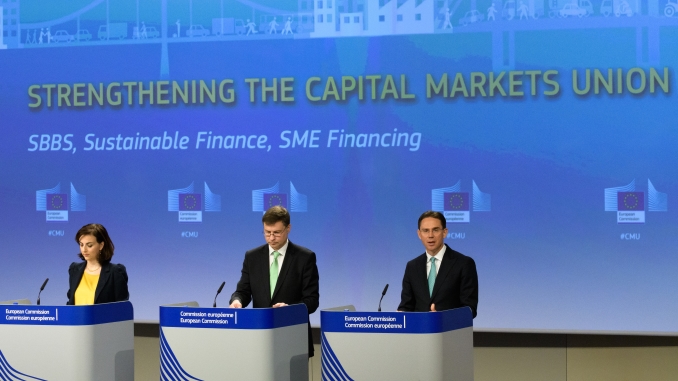
The European Commission unveiled its first legislative proposals aimed at gearing the EU financial system to tackle climate change yesterday (Thursday), including steps to establish a “groundbreaking” green taxonomy that could form the basis for an EU green bond label.
The proposals represent the European Commission’s first steps in implementing its sustainable finance action plan – unveiled on 8 March – into law, and were presented in a press conference yesterday by Valdis Dombrovskis, vice president responsible for financial stability, financial services and Capital Markets Union (CMU), and Jyrki Katainen, vice president responsible for jobs, growth, investment and competitiveness.
“The Titanic could not turn to avoid the iceberg at the last minute,” said Dombrovskis. “We will soon be in a very similar situation.
“Therefore we must not wait until the last minute, but act now, and the Paris agreement provides the course to follow.”
A centerpiece of the measures announced yesterday is a legislative proposal for the introduction of a unified EU classification system, or taxonomy, comprising harmonised criteria for determining whether an economic activity is environmentally sustainable.
“This is a groundbreaking step,” said Dombrovskis. “For the first time, we will assess sector by sector which economic activities are good for the climate and the environment, and we will lay the foundations for a single market for sustainable investment.”
The Commission said the classification system may serve as the basis for the future establishment of EU standards and labels for sustainable financial products – such as green bonds and investment funds – as announced in its sustainable finance action plan. A technical expert group currently being established by the Commission will be asked to issue a report on an EU Green Bond Standard, laying out the criteria and processes issuers should adhere to.
It will also support sustainable investment by providing certainty to investors and act as a guidebook for the development of green products, it said.
To establish this taxonomy, the Commission yesterday proposed a Regulation that lays out conditions for identifying environmentally sustainable economic activities, defines environmental objectives to which activities must contribute to be considered eligible, and empowers the Commission to establish technical screening criteria and frames how these criteria would have to be defined.
These technical screening criteria, which will be used to determine if and to what extent an economic activity is environmentally sustainable, will be separately established through delegated acts. These will be based upon advice from the technical expert group that is being established by the Commission.
Specific environmental activities will be identified in delegated acts to be adopted between end-2019 and mid-2022, with entry into force six months after the adoption. Dombrovskis said the Commission will start with the most urgent activities, climate mitigation and climate adaptation. He said classifications for these activities should be ready in the second half of 2019 and enter into force six months later.
Giving an example of how the classification system could work, Dombrovskis said that within the building sector, a housing project could be qualified as green based on its energy efficiency or based on the share of recycled building material used.
The Commission’s proposals also include regulation on investors’ duties and disclosures. Proposed rules put forward a harmonised EU approach to the integration of ESG risks and opportunities in the procedures of institutional investors, asset managers, insurance distributors and investment advisors, as part of their duties to clients.
“By considering sustainability, these managers can more fully assess long term risks and opportunities, and not only short term financial returns,” said Dombrovskis. “That is why we will clarify that their duty towards their clients includes making sustainability risks a part of their decision-making process.”
Under the proposals, asset managers and institutional investors who claim to pursue sustainability objectives would have to disclose how their investments are aligned with those objectives, preventing greenwashing, said the Commission.
A public consultation has also been launched on amendments to MiFiD II and IDD delegated acts that would require investment firms and insurance distributors to ask clients about their ESG preferences and take these into account in their advice. The public consultation will close on 21 June.
“Our proposal will clarify the existing obligation to act in the best interest of the client, and investment advisers and portfolio managers will have to offer investment products that meet client’s investment objectives,” said Katainen. “This should make it easier for people to access sustainable and green investments, and boost the inclusion of these assets in investment portfolios.”
Another legislative proposal puts forward the establishment of a new category of benchmarks. These comprise low carbon benchmarks, selecting underlying stocks on account of their reduced carbon emissions when compared to stocks constituting a standard benchmark, and positive carbon benchmarks, which would select only underlying stocks where carbon emission savings exceed the stock’s residual carbon footprint.
The latter – described by Dombrovskis as a “more ambitious benchmark” – is the only type of benchmark that would be compliant with the 2° objective in the Paris Climate Agreement, the Commission said.
Minimum standards for the methodology of these benchmarks would be established by the Commission in a delegated act.
The legislative proposals put forward yesterday regarding the EU classification system, low carbon benchmarks, and disclosure requirements are now subject to approval from the European Parliament and Council.
The new measures, and the Commission’s wider sustainable finance action plan, were informed by recommendations from the EU High-Level Expert Group (HLEG) on sustainable finance, which was appointed by the Commission last year and submitted a final report on 31 January.
In a statement, the HLEG said its members are delighted to see the Commission take the first steps in implementing its action plan.
“The legislative package released today honours the ambition and several of the highest priorities of the HLEG,” it said. “Comprehensively reforming the financial system to a sustainable approach will take time, and we believe the proposals announced today establish essential reforms and set firm foundations for realising the HLEG vision.”
The proposals unveiled yesterday were welcomed by many in the finance industry. Martin Scheck, chief executive of the International Capital Market Association (ICMA) noted the proposals reflect some of the highest priorities of the HLEG, in which ICMA participated.
“Going forward, a key priority should be to ensure that there is an appropriate balance between legislative and market initiatives, enabling the capital markets to finance sustainable growth whilst minimising unintended regulatory complexity or legal uncertainty,” he said.
“The financial sector can indeed contribute decisively to Europe’s environmental objectives, providing opportunities for its companies and citizens to foster sustainable economic activities leading to growth and job creation, and ICMA looks forward to continuing its work in this important area.”
But Invest Europe CEO Michael Collins expressed concerns that the proposed rules “might be too burdensome and even create barriers to entry” to sustainable investments.
“Further work on providing the actual detail should take into account the breadth and diversity of an industry that spans small local VCs and large buyout houses,” he said. “The key challenge will be to determine criteria for the environmental objectives so investments can be effectively assessed by investors of all sizes.
“Requirements on incorporating and reporting ESG matters should be proportionate and allow for flexible implementation.”
Photo: European Commission spokesperson Vanessa Mock, Domrovskis and Katainen announcing the proposals; Credit: EC/Georges Boulougouris; Copyright EU



